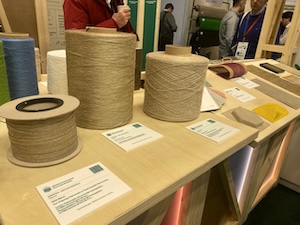 PARIS — May 19, 2025 — The Alliance for European Flax-Linen & Hemp is proud to spotlight a growing wave of innovative architectural and civil engineering applications featuring flax and hemp fibers. As the global construction industry turns toward sustainable solutions, flax and hemp are emerging as high-performance, low-impact alternatives for a new generation of bio-based architecture.
PARIS — May 19, 2025 — The Alliance for European Flax-Linen & Hemp is proud to spotlight a growing wave of innovative architectural and civil engineering applications featuring flax and hemp fibers. As the global construction industry turns toward sustainable solutions, flax and hemp are emerging as high-performance, low-impact alternatives for a new generation of bio-based architecture.
 Pioneering Structural Applications
Pioneering Structural Applications
For the first time, flax is stepping beyond interior and insulation use to form key structural elements in buildings. At the forefront of this transformation is the University of Stuttgart’s ITECH Research Pavilion 2024 program in Germany. Two extraordinary lightweight structures have been created using filament-wound flax fibers, demonstrating the material’s strength and design flexibility.
The main pavilion, a semi-permanent structure, features 20 flax fiber roof beams, crafted from Terre de Lin’s 100 Tex rovings and industrially processed by HA-CO Carbon GmbH. A second, smaller pavilion incorporates cowound wood and Safilin’s 200 Tex flax fibres in its columns and roof structure. Both projects highlight coreless robotic winding technologies and deliver striking examples of sustainable construction methods.
Sustainable Façade Innovation
Flax is also proving its value in cladding and façade systems. French manufacturer Temca recently completed 880 lightweight shading panels using Bcomp’s ampliTex™ flax fibre material for the Cité Scolaire Internationale Jacques Chirac business school in Marseille. Designed by renowned architects Rudy Ricciotti and Roland Carta for Bouygues Bâtiment Sud-Est, the system uses RTM-moulded ampliTex™ combined with UV-resistant gelcoat and fire-rated resin, providing a nature-inspired, energy-efficient solution with drastically reduced weight and hardware requirements compared to traditional materials.
Meanwhile, Dutch composite innovator NPSP continues its work integrating bio-based materials in public infrastructure. In collaboration with Alliance member Procotex and material partner Nabasco, NPSP has delivered striking façades across Europe, including the vibrant green cladding of Amsterdam’s NEMO Science Museum, designed by Renzo Piano. Nabasco® Natural panels offer both design freedom and top fire safety standards, paving the way for bio-based façades in modern urban design.
Civil Engineering and Urban Greening
DEMGY, a leader in recyclable moulded composites, has partnered with green roof experts PLANTIKA to introduce FLAXCOMP® sandwich base panels for rooftop garden modules. Replacing aluminum with perforated flax composites, the solution enhances water drainage and aeration while reducing environmental impact. If successful, the trial may lead to full flax composite construction in future urban greening projects, marking a critical advance toward circular building solutions.
“These projects reflect the growing ambition of our industry to deliver carbon-smart, beautiful, and high-performing structures using natural European fibers,” said Bruno Pech, Innovation Project manager.
The Alliance for European Flax Linen and Hemp continues to support its members and partners in advancing bio-based innovation across architecture and civil engineering.
Posted: May 20, 2025
Source: The Alliance for European Flax Linen and Hemp




